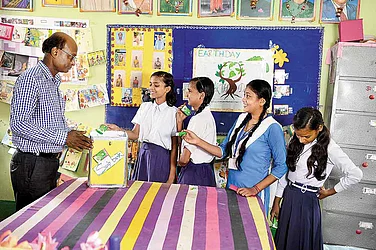- 36% of Indian mobile users will own a smart phone in 2022, up from 26% in 2018
- 5 billion people possess a mobile worldwide; the figure in India is over a billion, and going up
- 9.8 GB is the average data usage per smart phone in India; it will almost double to 18 GB by 2024, fuelled by video
No one can deny the benefits of the ongoing mobile revolution. With over one billion subscribers, and 80% active owners, the mobile phone has impacted the political, social and economic lives of Indians. No one has escaped the clutches of the mobile. As a service provider ad-line said, “Always with you”. For the mobile generation, the wireless device is, said a 2007 report by Aspen Institute, “not so much a phone as an ‘always on’ digital communicator”. One just cannot live without one.
Today, video calls organize religious rituals, texts run vending machines, and mobile apps help you watch music and movie videos, and book tickets for travel, stay and entertainment. Farmers auction their crops through the mobile, governments aim to reduce corruption, and businesses become more efficient and profitable. The mobile allows you to stay in touch 24x7 with family and friends. Today, one may have friends on social media, whom they have never met or intend to do so.
The sky is the limit; the reach of the telecom towers and their signals is the new technological frontier. You can do almost anything with a smart phone. The Internet generation has transformed into a mobile-first one in most countries. In India, one may soon have a mobile-only generation, a set of young people, both in urban and rural areas, which has access to a single device, a mobile phone, that’s used to live real, digital, sometimes virtual, lives. The upheaval this may cause isn’t obvious, or logical.
Life, as they say, is on the go. More than other nations, except China, India is on-the-go. Marshal McLuhan, the renowned media-technology expert, predicted that technology would become an extension of human senses, like touch, hearing and speech. Today, the mobile is an extension of the human’s physical, emotional and intellectual connections. People can’t live without their mobile phones; even when they sleep, they put it under their pillow or keep it within their reach. New non-physical and virtual synapses have developed between our smart phones and our brains.
Such trends are visible across the globe. They are also seen in India, but more so in the restricted elite urban settings. It was inevitable that they would give birth to new myths about the great Indian mobile revolution. Most believe that India was a latecomer to the global mobile party. In fact, some think that it gate-crashed the bash. This isn’t true. The cellular technology that’s in vogue today was finessed only in the early 1990s, when India opened up the telecom sector for a range of services, including cellular.

By the early 2000s, the mobile was still a novelty. Its usage was restricted. In the US, the cellular population in 2003 was less than the respective users of laptops and Internet. In the same year, there were less than 1.2 billion global users, 33% in Europe and 40% in Asia, mostly in China. Users in India were less than a million in 1999; they grew to six million in 2002 and 13 million the next year. It was then that the wireless zoomed — by 2005, India had 41 million subscribers. By 2016, India crossed the one billion mark, and was closing the gap with China (1.5 billion in 2017).
Ironically, throughout the past two decades, even when the users’ base was low, tariffs and handsets were expensive, the telecom companies, or Telcos, bled financially. They were constantly resuscitated by the government. Today, due to these factors, as well as the cancellation of over 100 licences due to the 2G scam, and a series of mergers and acquisitions, only three major Telcos (Airtel, Vodafone and Reliance Jio) remain in the race. They are still engaged in cut-throat competition. Experts contend that only one will thrive, one will survive, and the third limp along.
This shaky state-of-affairs can be attributed to several factors. When tariffs were high, volumes remained low. Volumes picked up only when tariffs crashed. Revenues and profits rarely reached the threshold levels. Customers’ behaviour added to the imbroglio. For example, average revenue per user (ARPU) remained abysmally low. Between 1999 and 2005, the usage of minutes per subscriber per month more than doubled from 175 to almost 400 minutes. Yet ARPUs fell by over 70% during the same period.
In 2017, the average minutes of use per subscriber remained steady, at 441 minutes, but ARPUs further skidded by almost 90% to Rs 81 ($1.2 at the then exchange rate). India has among the lowest ARPUs in Asia. One of the reasons for the low ARPUs was that the mobile attracted a growing segment of ‘low-end consumers’, who found ways to cut down their costs. They use the mobile frequently, maybe as much or more than their richer counterparts, but mostly to receive calls, which are at zero-tariff.

They are generally pre-paid users, who keep their expenses in check. They shift continuously from one tariff plan to another to reduce their outgoing costs. Several users have multiple SIMs with different tariff plans. Many discard SIMs like disposable plastic bottles. Hence, Telecom Regulatory Authority of Indi (TRAI) insisted on ‘active users’, or those who had used their SIMs at least once in a few months. This figure ranged between 80% and 85% of the total subscribers’ base. A few experts felt that the actual figure is lower, thanks to ‘part-active users’, who use their SIMs in a semi-active manner. Such mobile owners include those who possess multiple SIMs that they use for specific purposes.
The myth-making in Indian telecom will make you believe that the lower classes benefit economically from the phones. This is true, but it is a limited phenomenon. Movable handsets largely provide entertainment and amusement platforms to users. They are not necessarily connected all-the-time, but use the mobiles in an offline mode. There are local stores that transfer data related to music, movies, and other forms of entertainment through Wi-Fi and Bluetooth at nominal costs. Users regularly (say, once a month) get data uploaded from them, and then listen to or view them offline. The mobile becomes their iPod, radio, TV, and movie theatre.

Offline use of mobile is a global phenomenon. For example, a blog on www.online-convert.com, as also other websites, lists several apps that “you can use on your phone without being online or using your cellular data. These 13 online apps can help provide hours of entertainment for occasions when you need to kill time”, especially when “you are taking a long trip somewhere, on your way to work, or waiting somewhere”.
Offline storage may become the next big thing. Already Google Cloud and others allow you to do so. As more such options become available, Indians will get hooked on to them. If Digital India, a government project that seeks to connect “rural areas with high-speed Internet networks” and improve “digital literacy”, is successfully completed, and all the villages and towns are wirelessly connected, online usage will increase. But, rest assured, Indians will not spend much on data. This is proved by Reliance Jio’s success, which offers low tariff plans.
Although the size of mobile users is growing, smart phones are still a minority. Most Indians use the basic phone or, what is called, a feature phone, which is semi-smart. The latter has only some features, and most of the mobile apps cannot be downloaded on it. This restricts data usage. The handset ownership pattern — the distinction between basic, feature and smart phone — comes with complex subtexts. It may lead to a new form of a digital divide that is more expansive and extensive than in the case of computers and Internet. Access to information will differ among the various owners of the handsets.
A gender-based digital divide already exists in rural and semi-urban areas. Studies found that access to the phone among women, especially girls, is restricted. When available, it is monitored by the males or elders. In addition, the women are not exposed to data. Similarly, the women, who own a phone, are more likely to possess a basic or feature phone, unless they are economically empowered. This is common even in urban areas, especially among the elderly, who use their phones to only make and receive calls.
This divide is likely to become ‘yawning’ if large sections of Indians emerge as ‘mobile-only’ users. For them, mobile will be the only device. Hence, the mobile divide — between owners of a basic model, one with a few features, and a smart phone, as well as between genders — will impact them more fiercely. Globally, in China, a fifth of online users were mobile-only in 2016. The figure in Brazil was a third of all the homes. Even in the developed nations, like the US and Canada, the percentages of mobile-only homes were a high 20% (2018) and 24% (2017), respectively. The mobile-only households, rather wireless-only ones, may comprise 30-40% of the homes in the US in 2022.
“These (mobile-only) people will have no active wired connection to their home — no coaxial cable, fibre-optic connection, or DSL copper line. Instead, they (will) rely solely on radio technology for their entire home Internet usage,” concludes a 2018 study by Deloitte, a global consultancy firm. Data from the various countries shows that the mobile-only trend is more likely to grip the rural users, and the differences with the urban consumers may be high, as much as over 10% in Turkey.
Logically, the mobile-only phenomenon will be more visible in low-income homes, compared to the higher-bracket ones. But the same study found that in many countries, 13-23% of the higher-income individuals “are also mobile-only”, and “wireless-only data isn’t only for those who can’t afford wired services”. Younger people are more likely to become mobile-only. This trend was visible in the seven countries surveyed in the above-mentioned study. It concluded that the youngest cohort (18-24) was twice as likely to be mobile-only than the oldest age group (55-65).
Single people, said the study, are likely to be high on mobile. “Although the differences in marital status were not statistically significant in all the (seven) countries, single people were on an average over 40% more likely to be mobile-only,” it explained. Such trends can only accentuate if better cellular mobile networks are available. In India, Digital India can become a game-changer, but it will also enhance the various forms of digital divide, and the spawning of mobile-only and mobile-mostly population.
Mobile-only, even mobile-mostly, generation behave in a different manner. When mobile becomes an extension of an individual’s mind and body, when the phone screen is the last thing you see before you sleep, and the first thing when you wake up, it impacts personalities in unconventional ways. For example, a 2017 article on www.theatlantic.com, said that such generations spend most of their free time on the phone. Their social transactions happen through calls, texts, videos, photographs, and sharing in the virtual and wireless world. Hence, they are “less likely to leave the house without their parents”, and be less willing to interact physically with people.
In developed countries like the US, according to the same article, they are less likely to “date”. It added that only about 56% of high-school seniors in 2015 went out on dates; for the Baby Boomers (born between the mid-1940s and mid-1960s) and Gen-Xers (born between the mid-1960s and mid-1980s), the number was about 85%. Even the dating style has changed. “The initial stage of courtship,” said the article, “which Gen-Xers called ‘liking’ (as in, ‘Ooh, he likes you!’), kids now call ‘talking’ — an ironic choice for a generation that prefers texting to actual conversation. After two teens have ‘talked’ for a while, they might start dating,” said the study.

A small section of urban Indian teens do behave similarly. They are confined to their bedrooms, when they are not in school, rarely go out, except to eat out and hang out with friends once in a while, and are constantly engaged with their phones. Parents have to urge teens to go out, literally kick them out, or take them out. For example, a 2014 paper by Kiran Bala, said that new (social) media interactions, now mostly over the mobile phone, were “redefining social roles that are more vulnerable to dissolution as interpersonal communication taking place on public platforms. In the crowd of hundreds and thousands of friends of social media, youth find themselves alienated in the real world.” The new social order, according to her, has strengthened “public and mass communication”, but weakened “interpersonal communication”.
The abovementioned piece on www.theatlantic.com said that the teens “who spend more time than average on screen activities are more likely to be unhappy, and those who spend more time than average on non-screen activities are more likely to be happy.” Such traits may leave the teens depressed. It’s common to hear the teenagers crib about boredom, lack of exciting things to do, and be mired in various forms of insecurities. In combination with other stressful factors at home or school, such feelings can force the new-gen to “dope out, tune in, and drop out”, a slight change from the 1960s slogan of “turn on, tune in, and drop out”.
These trends in India are restricted to sections of the upper middle, and rich classes. But as India becomes connected, mobile becomes the only medium of communication, and the proportion of smart phone increases, these issues will become pertinent.
- Younger people (18-24) are more likely to be a part of mobile-only generation
- Globally, single people are 40% more likely to be mobile-only, compared to the married one
- Those who spend more time on mobile screens are more likely to be unhappy


























